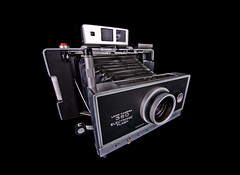Well, I get questions about Polaroid cameras from time to time, and I figured it's about time to have a post I can send people to when they need an answer, so here it is.
If you like the idea of getting into instant photography, there's currently only one type of film being produced, and that is made by Fuji. FP-100B or C and FP-3000B are the Fuji instant pack films, and they will fit older Polaroid Pack Film cameras. Okay, I know there are other films currently available, and Fuji has an integral film, but I'm trying to keep this guide simple. The camera pictured here is a 360, or what are referred to as "100-series" packfilm cameras. They were made by the millions, and aren't worth any more than maybe $20 now, by and large. They produce wonderful images very easily, with their high-quality glass lenses and automatic light metering. Basically point, focus, and shoot. The mechanics of the camera are easy enough to figure out, so I won't go into that here.
Polaroid also made some other packfilm cameras, most notably plastic things like the Colorpack II, and also some cheaper folding cameras like the more recent Reporter and ProPack models. They also made some expensive professional model packfilm cameras like the 195, but they require more skill and money to use and purchase.
I usually suggest getting one of the higher-quality packfilm cameras since they cost the same as the cheaper, and produce better images. Look for a model 100, 250, 350, 360, or 450.
A great resource for any Polaroid camera user is the Land List. Just go there and explore a bit, I'm sure you'll find the answer. A big FAQ for these cameras is battery type. They all used proprietary batteries, just look here to find out what yours needs. You can also adapt them to work on AAA batteries if you're handy. Before you start snapping away, try to clean the front and rear of the lens of dirt, and gently swab the film rollers on the loading door to remove years of dirt and grime.
Loading the camera is straightforward once you have the film. Just place the pack in the camera and close the film door, latching it shut. Proceed to pull out the long black tab and you're ready to shoot the first photo. When you've taken a photo, pull the small white tab and you should see a larger white tab exit through the film rollers. Pull that big tab firmly and entirely out of the camera, and wait the amount of time required. Grab the two flaps of the film and peel the negative from the print smoothly. Peel the print out of its paper frame, and that's it!
As you can see it's quite a hands-on process, and other people are usually intrigued by what's going on. Most people under 30 have no clue what it is, but older folks will often reminisce about the old Land Camera they used to have. Sometimes half the fun is seeing how people react to such a bulky funky camera.
Merry Christmas from Michigan in Pictures!
4 days ago



No comments:
Post a Comment